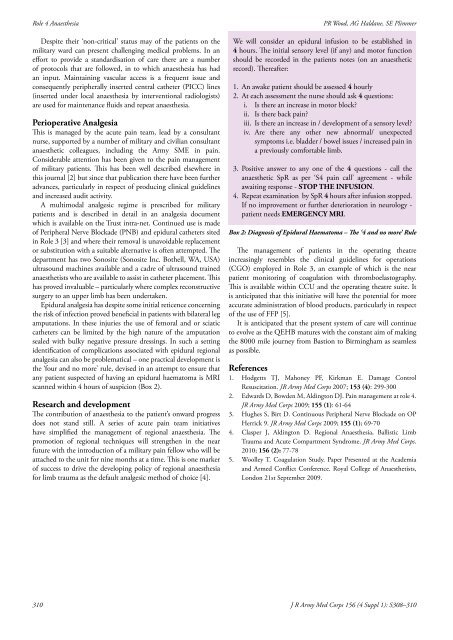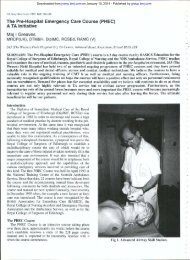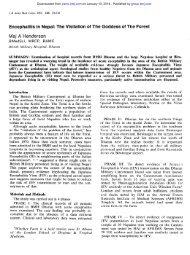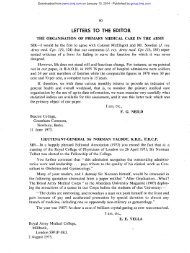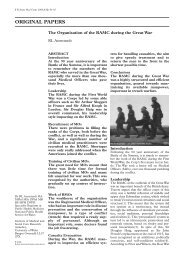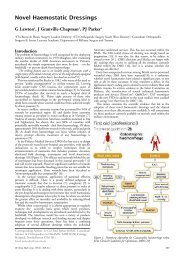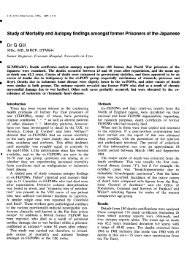Defence Anaesthesia - Journal of the Royal Army Medical Corps
Defence Anaesthesia - Journal of the Royal Army Medical Corps
Defence Anaesthesia - Journal of the Royal Army Medical Corps
You also want an ePaper? Increase the reach of your titles
YUMPU automatically turns print PDFs into web optimized ePapers that Google loves.
Role 4 <strong>Anaes<strong>the</strong>sia</strong><br />
Despite <strong>the</strong>ir ‘non-critical’ status may <strong>of</strong> <strong>the</strong> patients on <strong>the</strong><br />
military ward can present challenging medical problems. In an<br />
effort to provide a standardisation <strong>of</strong> care <strong>the</strong>re are a number<br />
<strong>of</strong> protocols that are followed, in to which anaes<strong>the</strong>sia has had<br />
an input. Maintaining vascular access is a frequent issue and<br />
consequently peripherally inserted central ca<strong>the</strong>ter (PICC) lines<br />
(inserted under local anaes<strong>the</strong>sia by interventional radiologists)<br />
are used for maintenance fluids and repeat anaes<strong>the</strong>sia.<br />
Perioperative Analgesia<br />
This is managed by <strong>the</strong> acute pain team, lead by a consultant<br />
nurse, supported by a number <strong>of</strong> military and civilian consultant<br />
anaes<strong>the</strong>tic colleagues, including <strong>the</strong> <strong>Army</strong> SME in pain.<br />
Considerable attention has been given to <strong>the</strong> pain management<br />
<strong>of</strong> military patients. This has been well described elsewhere in<br />
this journal [2] but since that publication <strong>the</strong>re have been fur<strong>the</strong>r<br />
advances, particularly in respect <strong>of</strong> producing clinical guidelines<br />
and increased audit activity.<br />
A multimodal analgesic regime is prescribed for military<br />
patients and is described in detail in an analgesia document<br />
which is available on <strong>the</strong> Trust intra-net. Continued use is made<br />
<strong>of</strong> Peripheral Nerve Blockade (PNB) and epidural ca<strong>the</strong>ters sited<br />
in Role 3 [3] and where <strong>the</strong>ir removal is unavoidable replacement<br />
or substitution with a suitable alternative is <strong>of</strong>ten attempted. The<br />
department has two Sonosite (Sonosite Inc. Bo<strong>the</strong>ll, WA, USA)<br />
ultrasound machines available and a cadre <strong>of</strong> ultrasound trained<br />
anaes<strong>the</strong>tists who are available to assist in ca<strong>the</strong>ter placement. This<br />
has proved invaluable – particularly where complex reconstructive<br />
surgery to an upper limb has been undertaken.<br />
Epidural analgesia has despite some initial reticence concerning<br />
<strong>the</strong> risk <strong>of</strong> infection proved beneficial in patients with bilateral leg<br />
amputations. In <strong>the</strong>se injuries <strong>the</strong> use <strong>of</strong> femoral and or sciatic<br />
ca<strong>the</strong>ters can be limited by <strong>the</strong> high nature <strong>of</strong> <strong>the</strong> amputation<br />
sealed with bulky negative pressure dressings. In such a setting<br />
identification <strong>of</strong> complications associated with epidural regional<br />
analgesia can also be problematical – one practical development is<br />
<strong>the</strong> ‘four and no more’ rule, devised in an attempt to ensure that<br />
any patient suspected <strong>of</strong> having an epidural haematoma is MRI<br />
scanned within 4 hours <strong>of</strong> suspicion (Box 2).<br />
Research and development<br />
The contribution <strong>of</strong> anaes<strong>the</strong>sia to <strong>the</strong> patient’s onward progress<br />
does not stand still. A series <strong>of</strong> acute pain team initiatives<br />
have simplified <strong>the</strong> management <strong>of</strong> regional anaes<strong>the</strong>sia. The<br />
promotion <strong>of</strong> regional techniques will streng<strong>the</strong>n in <strong>the</strong> near<br />
future with <strong>the</strong> introduction <strong>of</strong> a military pain fellow who will be<br />
attached to <strong>the</strong> unit for nine months at a time. This is one marker<br />
<strong>of</strong> success to drive <strong>the</strong> developing policy <strong>of</strong> regional anaes<strong>the</strong>sia<br />
for limb trauma as <strong>the</strong> default analgesic method <strong>of</strong> choice [4].<br />
310<br />
PR Wood, AG Haldane, SE Plimmer<br />
We will consider an epidural infusion to be established in<br />
4 hours. The initial sensory level (if any) and motor function<br />
should be recorded in <strong>the</strong> patients notes (on an anaes<strong>the</strong>tic<br />
record). Thereafter:<br />
1. An awake patient should be assessed 4 hourly<br />
2. At each assessment <strong>the</strong> nurse should ask 4 questions:<br />
i. Is <strong>the</strong>re an increase in motor block?<br />
ii. Is <strong>the</strong>re back pain?<br />
iii. Is <strong>the</strong>re an increase in / development <strong>of</strong> a sensory level?<br />
iv. Are <strong>the</strong>re any o<strong>the</strong>r new abnormal/ unexpected<br />
symptoms i.e. bladder / bowel issues / increased pain in<br />
a previously comfortable limb.<br />
3. Positive answer to any one <strong>of</strong> <strong>the</strong> 4 questions - call <strong>the</strong><br />
anaes<strong>the</strong>tic SpR as per ‘S4 pain call’ agreement - while<br />
awaiting response - STOP THE INFUSION.<br />
4. Repeat examination by SpR 4 hours after infusion stopped.<br />
If no improvement or fur<strong>the</strong>r deterioration in neurology -<br />
patient needs EMERGENCY MRI.<br />
Box 2: Diagnosis <strong>of</strong> Epidural Haematoma – The ‘4 and no more’ Rule<br />
The management <strong>of</strong> patients in <strong>the</strong> operating <strong>the</strong>atre<br />
increasingly resembles <strong>the</strong> clinical guidelines for operations<br />
(CGO) employed in Role 3, an example <strong>of</strong> which is <strong>the</strong> near<br />
patient monitoring <strong>of</strong> coagulation with thromboelastography.<br />
This is available within CCU and <strong>the</strong> operating <strong>the</strong>atre suite. It<br />
is anticipated that this initiative will have <strong>the</strong> potential for more<br />
accurate administration <strong>of</strong> blood products, particularly in respect<br />
<strong>of</strong> <strong>the</strong> use <strong>of</strong> FFP [5].<br />
It is anticipated that <strong>the</strong> present system <strong>of</strong> care will continue<br />
to evolve as <strong>the</strong> QEHB matures with <strong>the</strong> constant aim <strong>of</strong> making<br />
<strong>the</strong> 8000 mile journey from Bastion to Birmingham as seamless<br />
as possible.<br />
References<br />
1. Hodgetts TJ, Mahoney PF, Kirkman E. Damage Control<br />
Resuscitation. JR <strong>Army</strong> Med <strong>Corps</strong> 2007; 153 (4): 299-300<br />
2. Edwards D, Bowden M, Aldington DJ. Pain management at role 4.<br />
JR <strong>Army</strong> Med <strong>Corps</strong> 2009; 155 (1): 61-64<br />
3. Hughes S, Birt D. Continuous Peripheral Nerve Blockade on OP<br />
Herrick 9. JR <strong>Army</strong> Med <strong>Corps</strong> 2009; 155 (1); 69-70<br />
4. Clasper J, Aldington D. Regional <strong>Anaes<strong>the</strong>sia</strong>, Ballistic Limb<br />
Trauma and Acute Compartment Syndrome. JR <strong>Army</strong> Med <strong>Corps</strong>.<br />
2010; 156 (2): 77-78<br />
5. Woolley T. Coagulation Study. Paper Presented at <strong>the</strong> Academia<br />
and Armed Conflict Conference. <strong>Royal</strong> College <strong>of</strong> Anaes<strong>the</strong>tists,<br />
London 21st September 2009.<br />
J R <strong>Army</strong> Med <strong>Corps</strong> 156 (4 Suppl 1): S308–310


